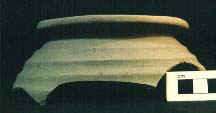 |
Ipswich Thetford-type Ware
Site: Copdock Interchange, Ipswich.
Period: Late Saxon (mid 9th-11th centuries AD).
Excavator: Suffolk C.C. Archaeological Service.
Published: internal report.
Brief description: Thetford-type ware is so-called because kilns for the manufacture of this Late Saxon wheelmade pottery were first uncovered in Thetford. However, it is likely that the ware developed in Ipswich, where kilns have also been excavated, and was first made by Ipswich ware potters in the late 9th century. It is a medium sandy greyware, although fine and coarse fabrics are also known.
The main forms are plain jars with everted rims, but other forms included spouted bowls and pitchers, large strapped storage jars, handled jars and lamps.
This jar is typical of Ipswich Thetford-type ware. It is in a relatively fine blue-grey sandy fabric and is girth-grooved. Other forms of decoration included bands of diamond rouletting (produced using a tool similar to a pastry wheel), applied thumbed strips, and occasionally incised wavy lines.
Thetford-type ware was produced in several areas. The main kilns were in urban centres such as Ipswich, Thetford and Norwich. It is possible that pots of this type were also being made in Sudbury and possibly Bury St. Edmunds. Rural production sites have been identified at Grimston and Langhale in Norfolk, but there were probably others. Late Saxon pottery of similar form and type was also being made in the South, Midlands and North (for example in Winchester, Torksey, Northampton and York). Shelly wares with the same forms were produced in the St. Neot's area (Cambridgeshire), and fine whitewares similar to Late Saxon imported wares were being made in Stamford. The latter were often glazed with a thin yellow or pale green lead glaze.
Further reading
Dallas, C., 1984, 'The pottery', in Rogerson, A. and Dallas, C., Excavations in Thetford 1948-59 and 1973-80 , East Anglian Archaeology 22, pp. 117-66. Norfolk Archaeological Unit.
Hurst, J., 1976, 'The pottery', in Wilson, D. (ed.), The Archaeology of Anglo-Saxon England, Cambridge University Press, pp.314-48 (Late Saxon). |